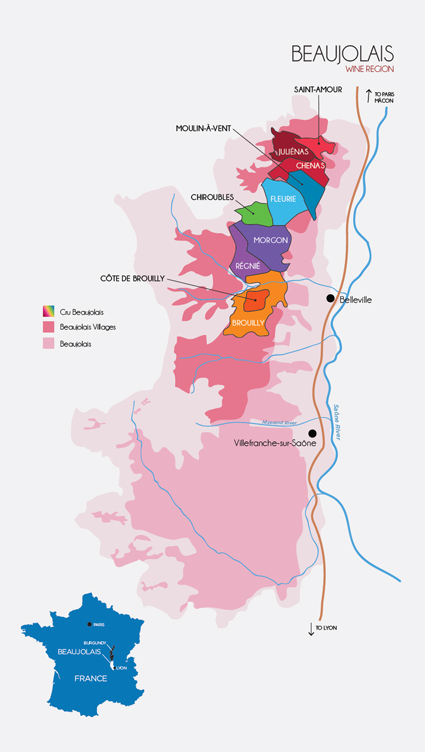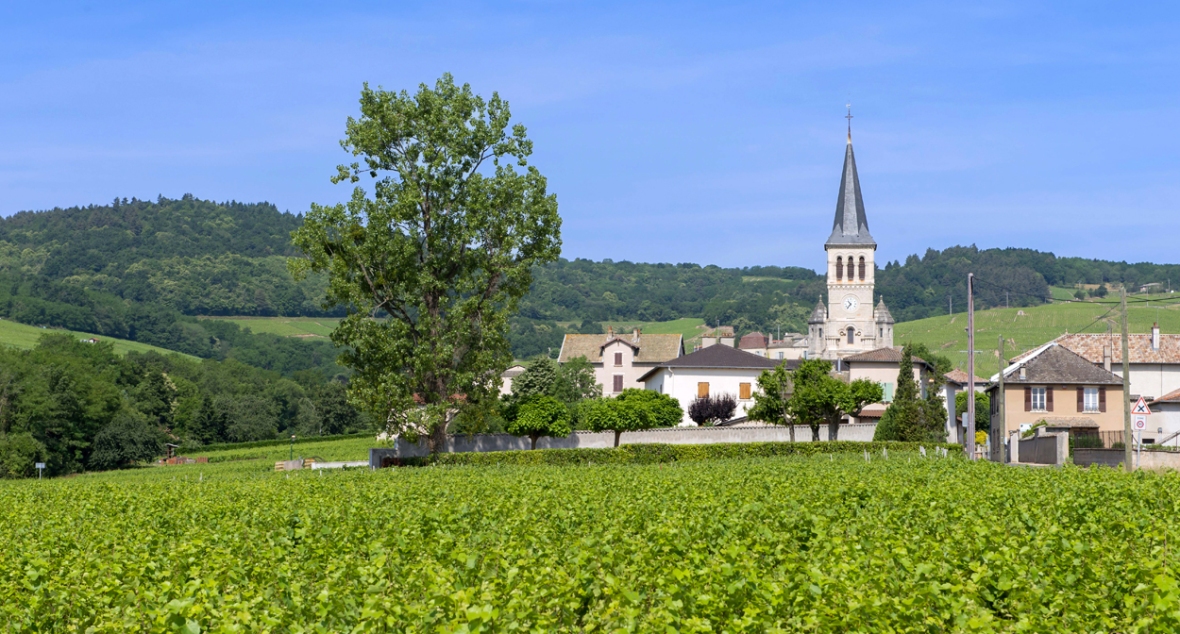This article explains the most prestigious wine of Beaujolais, a wine region in France.

It occurred to me, during the last few days of Beaujolais Noveau bustle and celebrations, that the Beaujolais region in specific teaches us about French wine on the whole. One of the things people tell me is that they don’t understand French wine, that they don’t know how to get what they want from it. In my opinion, the perceived doubt and confusion comes from the label system.
A Primer on Terroir and Labels
The label on a French wine holds the key to discovering where the wine grapes were grown. This is important in wine because of terroir. Terroir is the essence of an exact spot on Earth, the soil, the light, the climate, the wind…all of the blessings of mother nature create terroir. The beautiful thing about wine is that, because the vines feed of on all these elements, they transfer them into the wine. For this reason, studied wine drinkers can pick out characteristics in wine that lead them to know where exactly it came from. Certain spaces in the world have such a distinct terroir that identifying a wine with those spaces is paramount.
The French wine system requires that wine is labeled according to where it comes from in a system of precise understanding. If a wine drinker becomes familiar the system and gains a sense of place, the label goes a great distance to capturing what the wine might taste like. The system requires that particular grapes and methods are used before the label can go on. For this reason, we’ll never have Cabernet grapes of any sort in our mouth when we drink, for example, a Beaujolais wine… the nature of a Beaujolais wine is that it will only contain Gamay (or in some instances, Chardonnay) grapes.
The Beaujolais Region, in General and in Specific

But there is more to it; climbing into Beaujolais paints a picture. Visit French Wines describes the situation of Beaujolais:
“The vineyards of the Beaujolais region cover 15,733 hectares and rise to an average altitude of 300 metres. In the north, the vineyards situated between Lyon and the upper reaches of Burgundy reveal the 10 famous wines of the region, which clearly show the successful alliance between the Beaujolais soils and the Gamay grape variety. The Beaujolais Villages vines surround the vineyards of the famous listed wines, extending the wine route and offering delicious fruity wines. Further south, close to Lyon, the Beaujolais vines produce wines which combine freshness and taste in a landscape reminiscent of Tuscany.”
“Beaujolais” means the vineyard is in the Beaujolais region, but not from one of the designations above. This wines are light-bodied and fruity, rustic and quaffable. Great with dinner, think pizza, pasta, chicken and casseroles.
The “Beaujolais Villages” are also distinct, meaning that vineyards in and around the designated villages may label themselves as such. In Beaujolais the term villages may sweep any and all of the applicable villages or an individual village may be able entitled to place their name on the label. In these wines, grown in granite and sand, expect more complexity, purple-fruit flavors and a generous mouth-feel.
A note, the Beaujolais Noveau, the first wine of the season, was recently released. These are Beaujolais wines drank in the season they were grown, on November 17, 2016 this year’s harvest was celebrated. It can be
The 10 Famous Wine Regions

Gamay vineyards. Photo credit: Wikimedia Commons
The “10 famous wine regions” in the are the Crus. A cru is a vineyard, or a collection of vineyards, that are entitled to a specific status. If a bottle has a cru label, it translates to higher-quality (presumably) and distinct terroir characteristics. These wines come from primarily granite soils and are cultivated with pure attention to quality. They are elegant, complex and rich. These are compared to the finest of Burgundy wines (the neighbor, and sometimes-cohort to the north). They can age, they have finesse and they are valuable but not terribly expensive. Collectors and enthusiasts have been turned on to these wines recently, seeing and opportunity to taste an incredible, affordable wine with insider panache.
All of Beaujolais has a tradition of hand-harvesting as well as a current strong commitment to preserving the ecosystem. Attention to soil quality, characteristics and erosion is of particular concern. Soil experts advise winemakers on the quality and living nature of their soils, which are considered holy to the terroir of the wine. All Beaujolais Cru wines are red, made of the Gamay grape.
There are 10 crus in Beaujolais: “Over mainly granite terrain, the Beaujolais Crus form a meandering path. From south to north, Brouilly is followed by Côte de Brouilly, Régnié, Morgon, Chiroubles, Fleurie, Moulin-à-Vent, Chénas, Juliénas and Saint-Amour.” says InterBeaujolais. Each has unique characteristics, not a blanket profile, but genuinely distinct and worth a shot at tasting them all! Below is a playful statement about each of one of them, shedding light on what wine lovers, local sources and experts find unforgettable about the 10 famous wine regions:
Saint-Amour: “This light, easy-drinking cru is the most northerly of the ten, characterized by soft red fruit.” ~Courtney Schiessl for VinePair
Juliénas: “Local growers say it is one of the most varied areas of the region.” ~InterBeaujolais
Chénas: “Chénas produces weighty wines that are full, generous and, at their best, seductively rich” ~Berry Brothers & Rudd
Moulin-à-Vent: “The most distinctive feature of the terroir here is the pink granite soils, which are shot through with veins of manganese.” ~WineSearcher
Fleurie: “If you’re just getting into red wines, the wines of Fleurie are a great place to start.” ~WineFolly
Chiroubles: “Around the village of Chiroubles, a type of sand called gore provides the grapes near-perfect growing conditions. The result is texture so delicate, Chiroubles is referred to as the “most Beaujolais” of all the Crus.” ~InterBeaujolais
Morgon: “bright, fleshy fruit with a palatable joie de vivre that was undoubtedly inherited from their creator.” ~Kermit Lynch on regional wines from Marcel Lapierre
Régnié: “Many Régnié vine growers use integrated and even organic vine growing and winemaking techniques. They husband their land and vines for future generations, limiting the use of chemical products.” ~InterBeaujolais
Côte de Brouilly: “The reds from Côte de Brouilly tend to be more concentrated and fuller in body…[wines] from Côte de Brouilly can age for several years.” ~Gail Appleson for St. Louis Post Dispatch
Brouilly: “Brouilly is one of the most famous and largest. The vines are planted on steep slopes.” ~Maison Joseph Drouhin
The French Winophiles

Photo Credit: D. Gillet/InterBeaujolais
This Saturday, November 19th get on twitter at 10:00 am central and look us up at #Winophiles.
When Michelle from Rockin’ Red Blog sent me her title for our French Winophiles visit to Beaujolais this weekend I realized she’s hitting on a topic that is resonate with the wines of Beaujolias: Beaujolais: Ah To Be Young Wild and Free. Michelle has some of the best wine and meal recommendations (set to music) so I know I’ll need to shop for wine immediately after I read her post!
I’m really excited to see what Jeff from FoodWineClick! has in store for us, because he’s recently returned from a trip to Beaujolais. His titles (yes, two) for our session will be A Fall Day in Beaujolais and Beaujolais: A Versatile Partner for Hunter’s Chicken. I’m so looking forward to the soothing and inspirational photos that Jeff always captures in his posts. He is seriously talented with the camera in the kitchen, and has a great spirit for noticing the best and brightest.
Martin from Enofylz Wine Blog is going to reveal how Beaujolais is A Great Everyday Red Wine. Martin has excellent taste in wine and he’s got a way of bringing people together over a great bottle. I’m always inspired to invite friends over to enjoy his suggested wines and food. He has a great time with his writing, his friends and family and is an exceptionally talented blogger.
Wendy from A Day in the Life on the Farm inspires me with her creativity. First, everything she makes sounds delicious and is sourced from incredible places…Second, she always has something cooking not only in the kitchen but on her blog. This month, she’s combining two topics to share Look What I’m Bringing to the #TastyParTEA and Sharing with #Winophiles. I’m so curious about this!
Are you ready for something outstanding at your table? Morning, noon or night; special occasion or regular day; sweet or savory: you need to consult Camilla from Culinary Adventures with Camilla. Her blog seriously has the most comprehensive collection of kitchen creativity anywhere. She’s so generous with sharing. Take her Beaujolais post for example: Sole Véronique with a Château Thivin Brouilly.Wow.
Gwendolyn from Wine Predator has something special in store for us as we visit Beaujolais. She’s actually got a chef involved and while that doesn’t seem fair, somehow I think it will be in our favor because we’ll get to steal her inspiration. Gwendolyn started blogging as Art Predator and took her eye for detail (she’s on the prowl) into the world of wine. Look for a surprise from her!
Join us on November 19th at 10:00 am central time on twitter. We’ll be there under the hashtag #Winophiles. There we will chat about wine, food and travel in the gorgeous setting of Beaujolais. Please consider saying hello and asking (or answering) questions. It would be our pleasure to hear from other Beaujolais lovers!
We’ve been all over France this year, immersing into wine regions one at at time. For more on what I’ve published at L’occasion, as well as links to all the other writers please visit my Winophiles category. Cheers!

I think the Crus offer the best value, but I love all styles of Beaujolais. Thank you for the journey.
LikeLiked by 1 person
I always so enjoy your posts. Very informative and helpful to those of us who are seeking to learn more about French wines
LikeLiked by 1 person
Thank you! It is a fascinating topic, certainly. Cheers!
LikeLike
Nice intro to the Crus, Jill!
LikeLiked by 1 person
Thank you! What a fun topic — your posts were essential reading this month. Looking forward to 2017!
LikeLike
Thanks, an interesting post. I am an annual visitor to Burgundy usually staying in Pommard for a couple of weeks, eat-drink-sleep-repeat! Each year we tell ourselves we must visit Beaujolais, but never do as we get so immersed in the people and culture around Beaune. So here’s the question “where to stay in Beaujolais that is central, lively, totally viniferous”?
LikeLike
Thanks for sharing your comment and you get a hi-five for that annual visit to Pommard. I’ve been able to visit Beaune in the spring the last couple of years and it is such a welcoming, wonderful spot.
Jeff from FoodWineClick! put together a fascinating post about his recent visit to Beaujolais — inspiration alert! https://foodwineclick.com/2016/11/18/a-fall-day-in-beaujolais-winophiles/
LikeLike